The preceding chapters each address a central objective of the MLMA. When each objective is effectively achieved, the management system as a whole is robust, responsive, and resilient. While this is an important goal under typical conditions, the challenges of climate change will require management to be flexible and adaptive, further underscoring the need for effective MLMA-based management.
Since the MLMA was drafted, the potential long-term impacts of climate change have become more clearly understood. As discussed below, climate change is expected to have broad impacts across marine ecosystems, as well as the societies and economies that depend on those ecosystems. Climate change may result in several physical changes to oceanic and nearshore systems, including increased temperature, ocean acidification, altered currents, increased storm frequency and severity, and higher sea levels. These physical changes may in turn affect ecosystem productivity and function, species abundances and distributions, habitat use and availability, and cues that some species rely on that indicate changes in the season. They may also affect the ability of fishing fleets to access resources, catch, and land fish, and impact port infrastructure. These changes are already occurring and may have wide-ranging implications for California’s fish stocks and fishing communities.
This chapter draws from a 2017 report by OST on adapting to climate change (PDF)(opens in new tab), which was developed as part of the information gathering phase of the Master Plan amendment process. This chapter focuses on how climate change may impact California’s fisheries and discusses the various ways in which management can prepare for these changes to maintain resilient ecological and socioeconomic systems.
A naturally variable system
Even in the absence of climate change, the CCE is one of the most variable marine ecosystems in the world due to the influence of the El Niño Southern Oscillation, Pacific Decadal Oscillation, and North Pacific Gyre Oscillation (Chavez et al. 2017). Because of these systems, climatic factors fluctuate on yearly and decadal (or longer) timescales. These factors create a challenging management landscape that is further complicated by the additional variability that climate change brings.
The CCE generally varies between relatively cool and warm regimes that differ in their environmental conditions, species composition and distribution, and overall food web productivity. Historically, warm and cool phases have been relatively consistent in terms of their accompanying conditions. In general, cool phases tend to be more productive because movement of subarctic water, cooler ocean temperatures, and stronger upwelling results in more nutrients available for phytoplankton, and consequently more food for higher trophic levels (Chhak and Di Lorenzo 2007). Warm phases are generally less productive. As the CCE cycles between cool and warm regimes, these environmental conditions drive recruitment, species composition and distribution, and overall production, all of which affect fishermen and their communities.
Species tend to respond differently to cool or warm periods. Within California, Market Squid, Dungeness Crab, Ocean (Pink) Shrimp, Northern Anchovy, and most groundfish(opens in new tab) are particularly productive under cool regimes. Under warmer regimes, including those associated with El Niño events, Pacific Sardine, Spiny Lobster, and California Halibut tend to thrive (Chavez et al. 2017). These species form the basis of major fisheries in California’s waters, and management must become more flexible to deal with potentially increased fluctuations due to climate change. In addition, the extent to which a given species is likely to be affected by climatic fluctuations depends on the life history and trophic level of the species (Chavez et al. 2017). For short-lived, planktivorous species such as Market Squid and Ocean (Pink) Shrimp, populations can respond dramatically to environmental conditions, and these fisheries tend to experience cyclical conditions. Conversely, long-lived piscivores, such as rockfish, are generally able to withstand climatic fluctuations with more modest year-to-year shifts in total population abundance or availability to fisheries (Field et al. 2006).
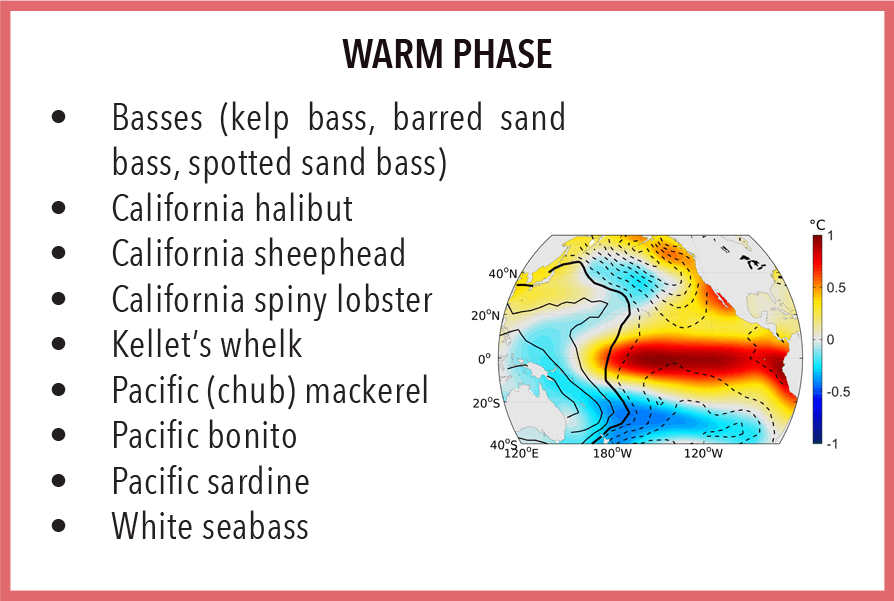 California fish and invertebrate stocks that favor warm El Nino phases. (OPC/Chavez et al. 2017 images)
California fish and invertebrate stocks that favor warm El Nino phases. (OPC/Chavez et al. 2017 images)
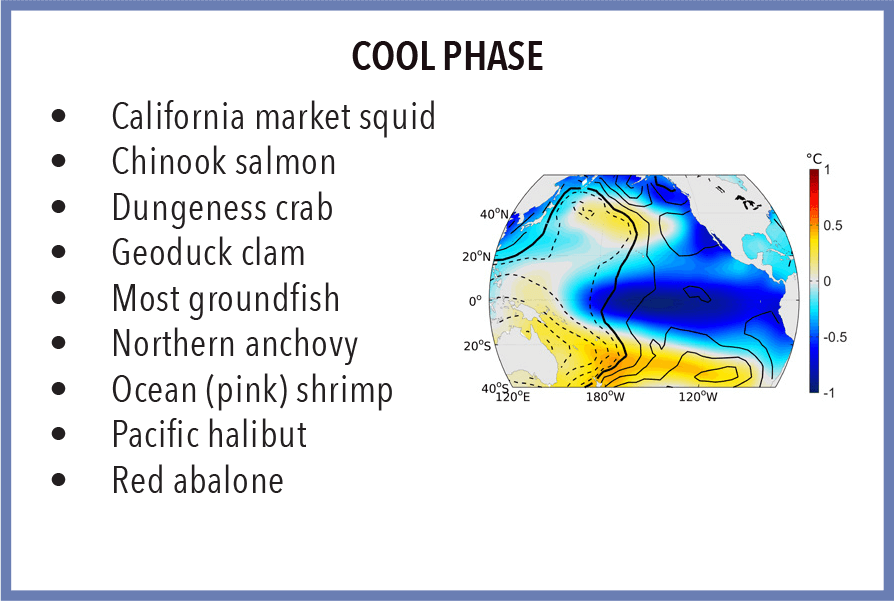 California fish and invertebrate stocks that favor cool El Nino phases. (OPC/Chavez et al. 2017 images)
California fish and invertebrate stocks that favor cool El Nino phases. (OPC/Chavez et al. 2017 images)
Measuring change
Understanding how normal climatic fluctuations within the CCE have affected fish stocks in the past may help managers prepare for climate change. Environmental indicators such as sea surface temperature and the Multivariate Ocean Climate Index, which looks at a range of oceanic conditions, can serve as valuable tools to characterize the degree to which the system is operating in a warm or cool regime. This information may be used to help assess the status of fish stocks and determine appropriate management responses. In addition, this information can help provide some insight into how these species, and the fishing communities that depend on them, may fare under climate change scenarios.
Environmental and ecological changes
Increased variability under climate change
Climate change may alter the natural cycles of the CCE by increasing the magnitude of variability in the system, leading to more extreme conditions. These changes are likely to result in large-scale impacts rather than the local-scale impacts that fishing pressure often exerts. For example, changes in atmospheric and oceanographic forcing may change the timing of natural fluctuations by increasing or decreasing the length of warm or cool states. Extreme environmental conditions, in turn, may increase the frequency or intensity of disease, parasite, or biotoxin outbreaks such as withering syndrome in abalone, sea star wasting disease, and harmful algal blooms; such outbreaks can have direct or indirect impacts on fisheries. For example, extremely warm temperatures contributed to unprecedented size and persistence of the 2015‐2016 harmful algal bloom event that led to temporary closures of the Razor Clam, Dungeness Crab, and Rock Crab fisheries.
Extended warming events and higher storm activity may also lead to declines in kelp abundance and distribution. Extreme marine heat waves have also contributed to a dramatic reduction in kelp distribution, particularly in northern California. Persistent warming over several consecutive years may reduce the capacity of annual kelp species (e.g.,
Nereocystis luetkeana) to successfully reproduce. Reduction in kelp has had both direct and indirect effects on species that depend on it for food and habitat. If the magnitude and timing of CCE’s variability changes, synergism among these impacts could lead to dramatic shifts in CCE dynamics with significant long-term implications for fisheries.
Changes in spatial distribution
Species that favor cool regimes such as Dungeness Crab, rockfishes, anchovies, and salmon are particularly vulnerable to climate change in California. Such species are predicted to shift poleward where conditions are likely to be more favorable. The distribution of subtropical species such as tunas, White Seabass, and Pacific Sardine is likely to expand poleward, leading to emerging fisheries in the north (Chavez et al. 2017). Some species may decline in abundance, particularly those with characteristics that prevent them from expanding their range (e.g., limited dispersal potential, specific habitat or prey requirements, etc.). Long‐lived species such as rockfish are likely to be more resilient to high variability. However, individual species declines or shifts may alter food web dynamics. Highly specialized species (e.g., specialized diets, habitat requirements, or complicated reproductive strategies) are more vulnerable to increased variability.
Changes to species life histories and food web dynamics
Changes in temperature may drive changes in the phenology (seasonal timing) and phenotypic expression (physical traits) of fishes and invertebrates. Species may display a shorter pelagic larval duration, faster growth, and younger age at maturity, which are more commonly observed in the tropics (Asch 2015). Changes in life history traits, particularly changes in timing, could lead to recruitment failures if shifts in timing result in temporal mismatches with the seasonal abundance of prey resources (e.g., spring bloom in productivity). For example, earlier spawning and shorter larval stages could result in a temporal mismatch between peak larval production and the production of zooplankton prey. Snyder et al. (2003) found evidence that climate change may lead to delays in the onset of the upwelling season, which further increases the likelihood of a temporal mismatch between larval production and spring blooms in productivity. Species that time reproduction and larval release to the spring bloom in productivity are particularly vulnerable to match-mismatch dynamics and, ultimately, reduced recruitment (e.g., rockfishes, Dungeness Crab).
Changing ocean chemistry
California is already experiencing physical changes to the properties of seawater that are consistent with climate change projections and have the potential to contribute to dramatic ecological shifts (Chavez et al. 2017). Scientists have observed an overall decline in seawater pH (Somero et al. 2016). Additionally, there has been an increase in frequency of conditions that can destabilize, dissolve, or prevent the creation of calcified structures such as shells and urchin tests, and projections indicate that these conditions will continue to increase (Feely et al. 2008; Harris et al. 2013). In addition to declining seawater pH, long‐term declines in oxygen content, as well as short-term hypoxic events during upwelling, have also been observed in the California Current (Feely et al.; McClatchie et al. 2010). Due to regional differences in oceanography, the impacts of climate change will differ in northern and southern regions of California. Upwelling intensification in northern regions may lead to more extreme acidification and hypoxia relative to the Southern California Bight.
Shifts in ecosystem function
Climate change may cause the CCE to undergo a dramatic shift in community structure, such that food web dynamics and ecosystem function are disrupted. There are many potential causes for this. Global warming and changes to atmospheric forcing in the Northeast Pacific will alter circulation patterns, mixing, and ultimately the physical parameters of seawater. Changing ocean conditions are projected to occur gradually over the coming decades, but the ecological impacts of these changes may manifest in sudden biological tipping points that shift ecosystems into dramatically altered states (i.e., crossing thresholds) (Selkoe et al. 2015). This could result in large changes to ecosystem function, with a possible effect being the rapid change in a fish stock’s abundance. Crossing this type of biological tipping point may reverberate through the food web and cause shifts in the state of the ecosystem.
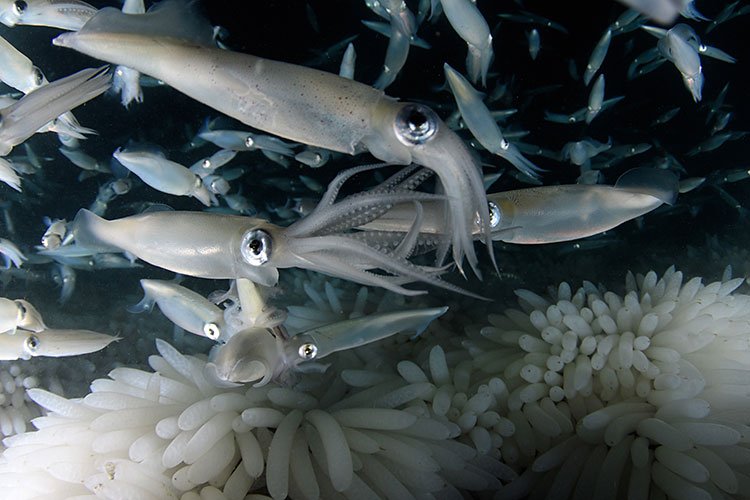 Squid mating at night over a field of freshly laid eggs off Redondo Beach, California. Squid tend to favor cool phases. They and other short-lived species can respond dramatically to changing environmental conditions. (Julian Gunther/Shutterstock photo)
Squid mating at night over a field of freshly laid eggs off Redondo Beach, California. Squid tend to favor cool phases. They and other short-lived species can respond dramatically to changing environmental conditions. (Julian Gunther/Shutterstock photo)
Managing for climate change
Climate change adaptation will require detecting the changes described above and responding to them in a timely manner to maintain sustainable fisheries. The State of California is committed to addressing the impacts of climate change (PDF)(opens in new tab). The following sections identify important management approaches that the Department will explore for meeting this challenge.
Maintaining ecological resiliency
Resilience is defined as the “capacity of an ecosystem to absorb recurrent disturbances or shocks and adapt to change while retaining essentially the same function and structure” (McClanahan et al. 2012).
The following management approaches are designed to maintain ecosystem resilience in fisheries affected by climate change.
- Reduce external stressors: One strategy for increasing resilience of stocks (and ecosystems) to climate change is to decrease existing stressors already impacting the stocks expected to be negatively affected by climate change (Sumaila et al. 2011; Stein et al. 2013; Pinsky and Mantua 2014). For species expected to be negatively impacted by climate change, the impacts from other stressors are more likely to have rapid and more acute reactions. Some examples of existing stressors include high fishing mortality, habitat degradation, invasive species, disease, and pollution.
- Identify vulnerable species: Some species will be more vulnerable than others to the ecological and oceanographic changes that result from a changing climate. Although there is uncertainty regarding the direction and magnitude of some of these changes over time within the CCE, potential changes from a range of climate scenarios can be examined. In California and elsewhere, efforts are underway to develop and evaluate tools for assessing species’ vulnerability and risk from climate change. Results from such assessments will provide valuable information to guide many facets of the MLMA-based management including prioritization, ERA, and ESR and FMP development. The Department will explore partnerships available for conducting such assessments as tool availability and resources permit.
- Apply a precautionary approach to fisheries management: The precautionary approach guides decision-making by assessing and managing for risks. Precaution in management actions is necessary because knowledge of ecosystems is incomplete. The precautionary approach ensures that excessive harvests are not made in the face of the considerable uncertainty associated with environmental variation. While it does not address climate impacts explicitly, the ERA framework described in Chapter 2 can help to identify risks in fisheries and where precaution may be particularly warranted. As noted in Appendix D, MPAs may help to provide additional precaution for some species.
- Protect age structure: Protecting or recovering the full age structure of a stock (the fraction of the population at different ages) can increase that population’s resilience to a changing environment. In a population with a full age structure, larger females tend to have larger, healthier eggs and more of them, which contribute to subsequent recruitment success. In addition, older and larger fish spawn over a longer time period, greater depth gradient, and an extended area when compared to younger fish. These mechanisms may help buffer stocks from recruitment fluctuations due to environmental conditions. Management options that may improve a population’s age structure include use of MPAs, minimum or maximum size limits, gear modifications to avoid catching juvenile fish, or fishery closures during times and over areas when large individuals congregate.
- Manage for genetic diversity: There are three components to the adaptive capacity of marine populations: 1) ability to adjust to new conditions; 2) ability to relocate if or when conditions change; and 3) ability to evolve strategies to survive in the new conditions (Beever et al. 2015). Each of these components requires high levels of genetic diversity within the population. Given the high rate of expected environmental change, genetic adaptation to climate change may be necessary, and management should aim to increase or preserve current genetic diversity. This may be accomplished through a variety of management approaches including maintaining large populations, robust size/age distributions, and connectivity across metapopulations.
- Protect key habitats: As discussed in Chapter 6, protecting key habitats and species can promote healthy marine ecosystems that are more resilient to environmental changes. Gear modifications that reduce impacts on habitats will result in a more resilient ecosystem (Sumaila et al. 2011). If habitats have become degraded, active restoration or creation of new habitat may be a viable management option. Efforts should be targeted at habitats that provide a role for many species during key periods of their lives, such as nursery grounds that protect larval stages, or those that provide a number of ecosystem services, such as wetlands. Since climate change is expected to decrease important coastal habitats, adaptation efforts aimed at offsetting anticipated losses could be helpful.
- Utilize MPAs: MPAs can be a valuable tool for protecting habitats from fishing impacts and may increase the resiliency to climate effects of both the species being protected and the associated ecosystem. For example, reserves with full protection have been shown to increase the abundance of older females of some species, which in turn improves the age structure of a stock while decreasing the influence of environmental variability on stock abundance (Berkeley et al. 2004). In addition, because marine reserves protect multiple trophic levels, they can help retain the functional diversity of an area, improving its ability to maintain basic ecosystem functions through a changing environment. MPAs also provide locations to observe and study how ecosystems react to climate change without the added stress of fishing.
- Use MSE: As discussed in Appendix L, MSE can help develop defensible, tactical guidance that takes climate-related uncertainties into account.
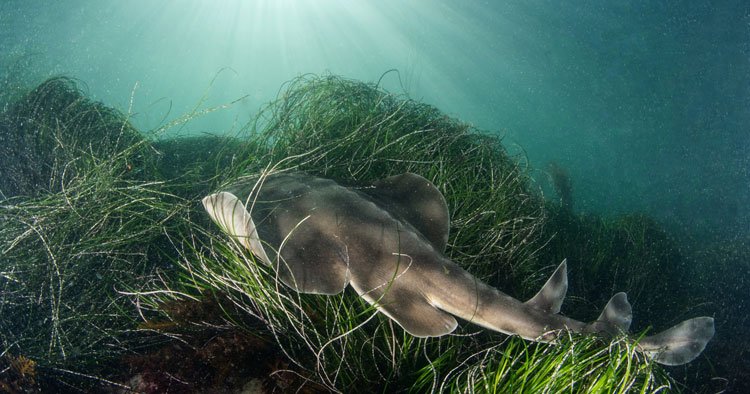 A Shovelnose Guitarfish swims over seagrass off La Jolla, California. Climate change is expected to decrease important coastal habitats such as seagrass. (Julian Gunther/Shutterstock photo)
A Shovelnose Guitarfish swims over seagrass off La Jolla, California. Climate change is expected to decrease important coastal habitats such as seagrass. (Julian Gunther/Shutterstock photo)
Maintaining socioeconomic resiliency
As fish stocks adjust their distributions and abundances, fishing effort may also have to adjust by changing the species targeted and the locations and times fished, as well as landing or processing locations. To adapt to a changing climate, fishermen may need to adjust where, when, and what they catch depending on conditions. Enabling them to do so may require changes in management, including permitting. The impacts of changes to the composition, magnitude, and timing of landings could be amplified if the shore-side processing and supply chain is not adaptable as well.
The following approaches are designed to help evaluate and maintain socioeconomic resiliency associated with fisheries affected by climate change:
- Evaluate options for flexible permitting: Flexible permitting mechanisms could provide a means to allow fishery participants to hedge their risk, adapt to variable production or unexpected closures, and respond to shifts in species spatial distribution or range shifts. Flexible permitting could include transferrable permits and integrating gear flexibility into permits or other regulations. One of the challenges of flexible permitting mechanisms, however, is effectively controlling effort and balancing the interests of all affected stakeholders. Any such increase in flexibility would need to be consistent with the Commission’s restricted access policy(opens in new tab). As resources permit, the Department and Commission will work with stakeholders to conduct an analysis of permit transferability in California fisheries and the Commission’s policy on restricted access fisheries. This analysis will include how permits are retired and new permits are issued, and the potential for gear switching. Permitting considerations will also be included in the development of new FMPs. A working group comprised of stakeholders, outside experts, and Department and Commission staff could help to interpret analyses and develop policy recommendations.
- Evaluate community vulnerability: Some communities will be more affected by climate change than others. There is a need to consider vulnerabilities of fishing communities to climate change impacts. For example, a vulnerability index that incorporates social and ecological indicators would allow communities to be ranked by their vulnerability, and could enhance the abilities to minimize adverse impacts on fishing communities when developing management plans and regulations. Vulnerability assessments should be scaled appropriately and should consider the interconnectedness of fishing communities at a regional scale.
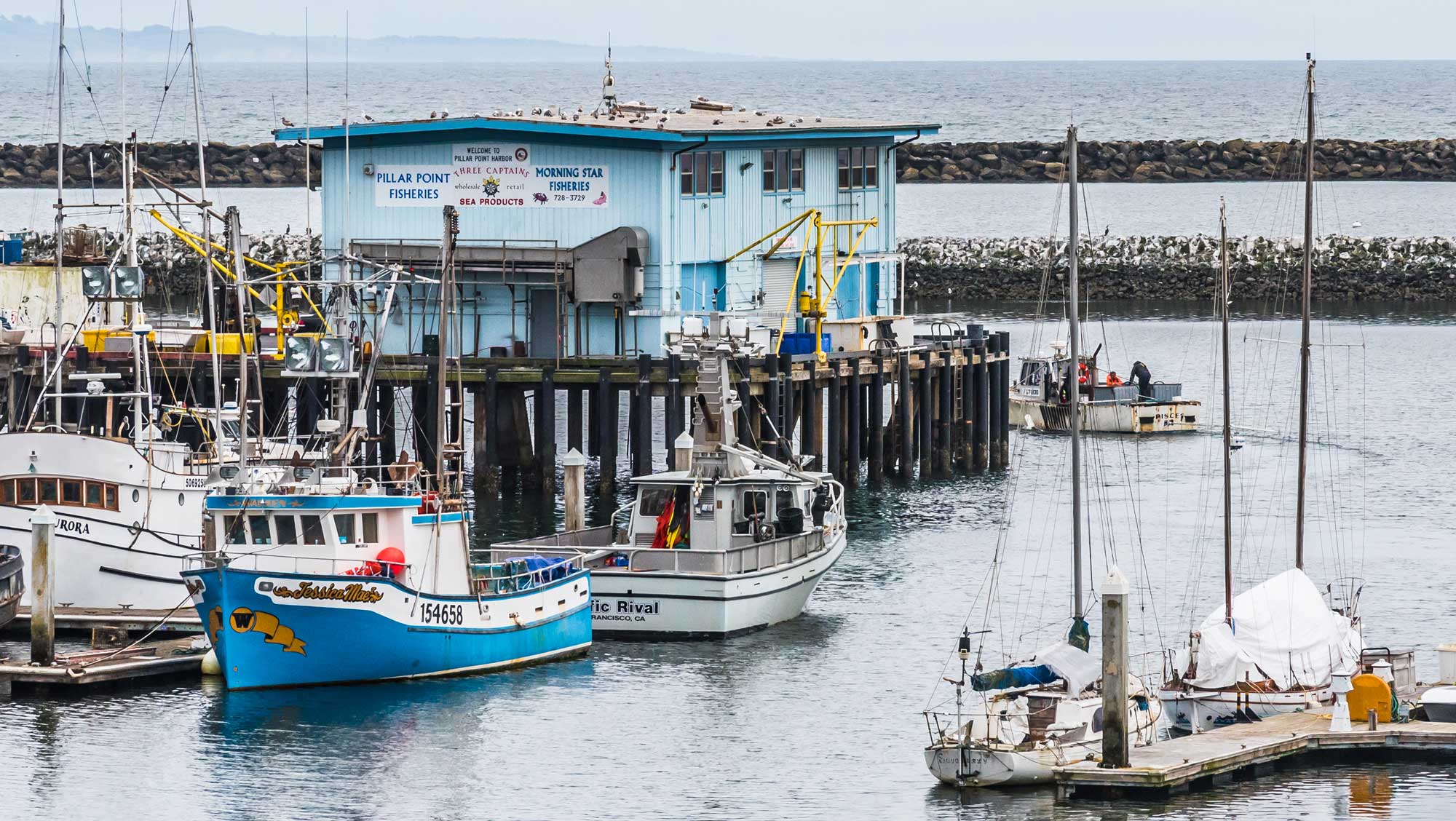 Fishing fleet at Pillar Point Harbor in San Mateo County. (David A. Litman/Shutterstock photo)
Fishing fleet at Pillar Point Harbor in San Mateo County. (David A. Litman/Shutterstock photo)
Supporting fisheries transitions and emerging fisheries
Changes in species distributions and abundance may lead to emerging fisheries (see Chapter 9). The Department and Commission will need to carefully balance the needs of fishing communities to remain flexible and diversify their portfolios, while protecting fish stocks during a time when their range may be changing. As noted, the development of emerging fisheries needs to be considered in light of existing priorities. The criteria for evaluating new proposed priorities identified in Chapter 2 can help to ensure that limited management resources are effectively targeted.
Strengthening monitoring and data used for management
Monitoring will be an important component of any strategy to detect and respond to climate change, including the following:
- Prioritize additional monitoring: Current monitoring programs may benefit from re-evaluation of their design and scope in light of climate change. It may be possible to use existing data collection in a new way to monitor climate change. For example, tracking the spatial distribution of fishing effort and landings may alert managers to range shifts. Newer technologies could also be considered when planning monitoring programs, to improve information acquisition while keeping costs low. For example, cell phones allow stakeholders to provide real-time catch or sightings information, and results from satellite remote sensing can be used to estimate area-specific phytoplankton productivity and predict the fish distribution and abundance. Development of new indicators—such as duration of spring blooms and the size or species composition of phytoplankton—could provide even better information relevant to predicting climate effects on fishing resources (Chassot et al. 2011). Understanding the link between physical oceanographic conditions and ecosystem health is critical and supporting and partnering with organizations that conduct monitoring should be a priority.
- Incorporate environmental parameters into stock assessments, MSEs, and HCRs: There is strong evidence to suggest that the productivity of many fish stocks is directly influenced by environmental variables. For species whose productivity is known to be dependent upon environmental conditions, appropriate environmental parameters may be integrated into stock assessments, MSEs, and HCRs. See Appendix L for more details. As knowledge of relationships between managed fish stocks and environmental dynamics continues to improve, there will be more basis for incorporating environmental factors into stock assessment and management.
- Incorporate spatial information into stock assessments, MSEs, and HCRs: Changes in species distributions can create management challenges, particularly when they cross jurisdictional boundaries. As the abundance or distribution of fish species is impacted by a changing climate, it may no longer be appropriate to follow the common practice of basing allocations on historical catch rates. Fish may be in a new location because their distribution has shifted or because the population has expanded into new habitat. Additionally, changes in habitat availability may result in changes in fish distribution. Including spatially‐explicit information in stock assessments will assist in capturing regional differences in environmental conditions that affect stock productivity. This may require coordination with neighboring states and countries.
Addressing potential climate change impacts in Enhanced Status Reports and Fishery Management Plans
To identify and better address the potential impacts of climate change and to allow for the adaptive management, ESRs and FMPs should specifically incorporate information on each of the following aspects:
- Changes in spatial distribution: A description of whether the species is anticipated to shift its distribution.
- Changes in abundance: A description of whether the species is anticipated to increase or decrease in abundance.
- Changes to species life histories: A description of whether the species is anticipated to alter breeding, feeding, growth, or other life history patterns.
- Changing ocean chemistry: A description of how potential changes in ocean chemistry might affect the species.
- Measuring change: A description of how these possible changes could be measured, and if possible, forecasted.
- Potential CFR opportunities: A description of potential opportunities for CFR to address climate-related research needs.
- Potential management impacts: A description of how the above changes may impact HCRs and other management strategies.
- Human impacts: A description of any anticipated effort shifts, altered timing of harvest seasons, expected conflicts resulting from shifting distributions, and other similar fishery dynamics.
California’s oceanographic and ecological system is dynamic, and this variability is likely to increase as climate change progresses. A flexible and responsive management system will be necessary to mitigate negative ecological impacts while capitalizing on new opportunities. Given the uncertainty inherent in climate change, a multi-pronged approach to facilitate adaption and resilience in California’s fisheries must be employed.
Photo at top of page: A fishing boat near Santa Barbara. (© David Hills, all rights reserved)